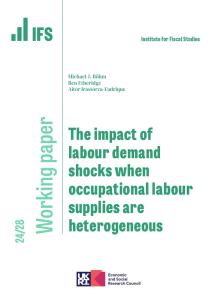Employing public sector workers to help deliver public services is a major part of what government does. The number of workers employed by the government and how much they are paid matters not just for those individuals and their families, but also for the public finances and for the public services those employees help provide. In this briefing note, we examine how the scale and make-up of public sector employment has evolved over the last 20 years. We then compare public and private sector pay, and outline the consequences of pay restraint since 2010 for differences between pay in each sector. Finally, we consider differences in workplace pension enrolment and the generosity of employer contributions to pensions in the public and private sectors.
Key findings
• The government currently spends £190 billion per year (22% of total public spending) employing around 5.3 million people. The public sector workforce is now around 310,000 (5.5%) smaller than it was at the start of 2010.
• More than 6 in 10 public sector workers (some 3.2 million people) are employed in the NHS or the education sector. A further 2 in 10 (around 1 million people) are employed in public administration (the civil service and local government). The numbers employed in HM Forces and the police have fallen substantially since 2010. The government’s promise to hire 20,000 extra police officers would return the number of officers to around its 2009−10 peak.
• Average earnings in both the public and private sectors remain below pre-crisis levels. Public sector earnings did not fall immediately during and after the Great Recession, but significant pay restraint after 2010 reduced average public sector earnings in 2014 Q2 to 4.7% below their level at the start of 2008. Public sector earnings have risen by around 2% in real terms since the end of 2017, but are not yet back to pre-crisis levels.
• The difference between public and private sector hourly pay has fallen to below pre-crisis levels, exacerbating problems with recruitment and retention. Pay restraint in the public sector has reduced the gap between public and private sector wages to the lowest level since the early 2000s. The public-private pay differential is not uniform across the country: public sector pay is lower relative to that in the private sector in London and the South East. This could lead to particularly acute shortages and recruitment challenges in those areas.
• Private sector pension enrolment has increased, and while public sector pensions have been cut they remain substantially more generous than those in the private sector. Public sector workers are both more likely to be enrolled in a pension scheme than their private sector counterparts, and more likely to receive generous employer pension contributions. In 2018 the vast majority (86%) of public sector workers received (implicit) employer pension contributions worth at least 10% of their earnings compared with only a small minority (10%) of private sector workers. This forms an important part of employee remuneration.












